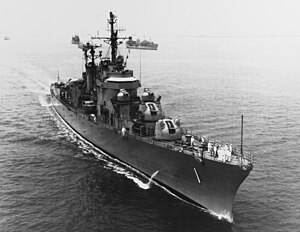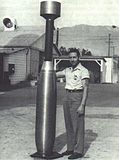
The RUR-5 ASROC is an all-weather, all sea-conditions anti-submarine missile system. Developed by the United States Navy in the 1950s, it was deployed in the 1960s, updated in the 1990s, and eventually installed on over 200 USN surface ships, specifically cruisers, destroyers, and frigates. The ASROC has been deployed on scores of warships of many other navies, including Canada, Germany, Italy, Japan, Taiwan, Greece, Pakistan and others.
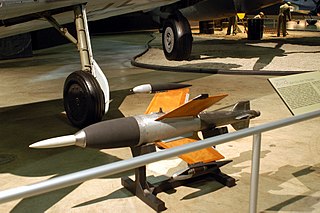
The Ruhrstahl Ru 344 X-4 or Ruhrstahl-Kramer RK 344 was a wire-guided air-to-air missile designed by Germany during World War II. The X-4 did not see operational service and thus was not proven in combat but inspired considerable post-war work around the world, and was the basis for the development of several ground-launched anti-tank missiles.

USS Triton (SS-201) was the fourth Tambor-class submarine to be commissioned in the United States Navy in the years leading up to the country's December 1941 entry into World War II. Her wartime service was in the Pacific Ocean. She completed five patrols in the following 14 months, and is credited with the sinking of over 20,000 tons of Japanese shipping and warships. She was lost with all hands on or around 15 March 1943. Of the twelve Tambor-class submarines, only five survived the war.
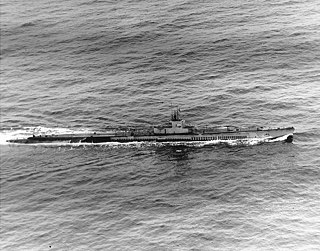
USS Tautog (SS-199), the second Tambor-class submarine, was the first ship of the United States Navy to be named for the tautog, a small edible sport fish, which is also called a blackfish. She was one of the most successful submarines of World War II. Tautog was credited with sinking 26 Japanese ships, for a total of 72,606 tons, scoring second by number of ships and eleventh by tonnage earning her the nickname "The Terrible T." Of the twelve Tambor-class submarines, she was one of only five to survive the war.

The Hedgehog was a forward-throwing anti-submarine weapon that was used primarily during the Second World War. The device, which was developed by the Royal Navy, fired up to 24 spigot mortars ahead of a ship when attacking a U-boat. It was deployed on convoy escort warships such as destroyers and corvettes to supplement the depth charges.
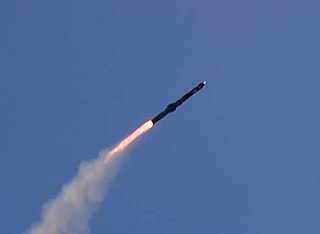
The RUM-139 Vertical-Launch Anti-Submarine Rocket is an anti-submarine missile in the ASROC family, currently built by Lockheed Martin for the U.S. Navy.

HMS A1 was the Royal Navy's first British-designed submarine, and their first to suffer fatal casualties.
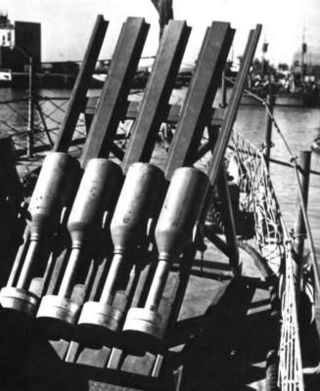
Mousetrap was an anti submarine rocket launcher used mainly during World War II by the United States Navy and Coast Guard. Its development began in 1941 as a replacement for Hedgehog anti-submarine mortar. Those were spigot-launched, which placed considerable strain on the launching vessel's deck, whereas Mousetrap was rocket-propelled. As a result, Mousetrap's four or eight rails for 7.2-inch (183 mm) rockets saved weight and were easier to install.

The UUM-125 Sea Lance, known early in development as the Common ASW Standoff Weapon, was to be an American standoff anti-submarine missile, initially intended to carry a W89 thermonuclear warhead. It was conceived in 1980 as a successor to both the UUM-44 SUBROC and RUR-5 ASROC anti-submarine missiles. The Sea Lance was to be available in two versions, known as UUM-125A and RUM-125A. The former would be a submarine-launched version, the latter surface-launched. It was cancelled in 1990 as its importance was obviated by the collapse of the Soviet Union.

The Howell Automobile Torpedo was the first self-propelled torpedo produced in quantity by the United States Navy, which referred to it as the Howell Mark I torpedo. It was conceived by Lieutenant Commander John A. Howell, United States Navy, in 1870, using a 60 kg (130 lb) flywheel spun at a very high speed to store energy and drive propellers.

Anti-submarine warfare is a branch of underwater warfare that uses surface warships, aircraft, submarines, or other platforms, to find, track, and deter, damage, or destroy enemy submarines. Such operations are typically carried out to protect friendly shipping and coastal facilities from submarine attacks and to overcome blockades.

USS Frazier (DD-607) was a Benson-class destroyer in the United States Navy during World War II.

An anti-submarine missile is a standoff anti-submarine weapon, often a specialized variant of anti-ship missile. Anti-submarine missile usually include a jet or rocket engine and a warhead aimed directly at a submarine. In these missiles, a torpedo or a depth charge is used as a warhead. The anti-submarine missile can be either a cruise missile or a ballistic missile.
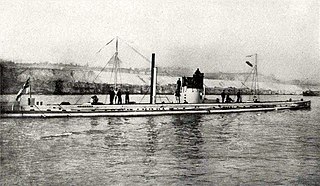
SM U-9 was a German Type U 9 U-boat. She was one of 329 submarines serving in the Imperial German Navy, and engaged in commerce raiding (Handelskrieg) during World War I.

The UUM-44 SUBROC was a type of submarine-launched rocket deployed by the United States Navy as an anti-submarine weapon. It carried a 25 kiloton tactical nuclear warhead configured as a nuclear depth bomb.

The D-class submarine was the Royal Navy's first class of submarines capable of operating significantly beyond coastal waters. They were also the first boats to be fitted with wireless transmitters. Ten were laid down between 1907 and 1910, though only 8 were completed as D-class boats. The final two hulls were completed as British E-class submarine.

HMS D4 was a British D-class submarine built by Vickers, Barrow. D4 was laid down on 24 February 1910, launched 27 May 1911 and was commissioned on 29 November 1911. She was the first submarine to be fitted with a gun for offensive use.

The Matsu-class destroyers were a class of destroyer built for the Imperial Japanese Navy (IJN) in the late stages of World War II. The class was also designated the Type-D Destroyer. Although sometimes termed Destroyer escorts, they were larger and more capable than contemporary United States Navy destroyer escorts or the Imperial Japanese Navy kaibōkan vessels.

Anti-submarine rocket is an anti-submarine weapon type deployed on surface ships for the purpose of sinking or damageing submarines by small explosive charges. They are similar to anti-submarine mortar but comparably more modern system. This type of weapon used rocket instead of spigot mortars to deliver the explosive.
